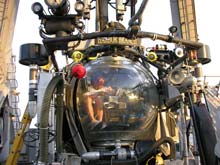
Lee Frey tests connections in preparation for launch of the Johnson-Sea-Link submersible. Click image for larger view.
“Deep Thoughts” from an Engineer…
August 31, 2005
Lee Frey
Ocean Engineer
Harbor Branch Oceanographic Institution
Latitude: 27° 41.671' N
Longitude: 90° 29.829' W
This morning I awoke to the familiar sound of the purring of the ship’s engines. To many, I suppose that this might be perceived as a cacophony of pistons and gears and thousands of controlled explosions every minute... an annoyance to many while trying to sleep. But to me, it is the music of physics, mathematics, chemistry, and human ingenuity, all working together in a well-orchestrated symphony, and it is, ultimately, what makes this expedition possible. Most technology is like this. When it works well, no one thinks about it. It exists in the background and few realize how much went into its development, or how much is needed to keep it running right. We just expect it to work.
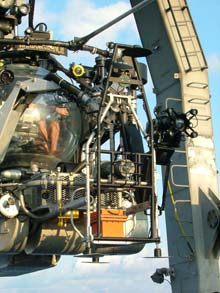
The Eye-in-the-Sea is held on the front of the JSL submersible during launch. Click image for larger view and image credit.
I am an Ocean Engineer (OE). Not many guidance counselors mentioned this profession was even an option, and there are only a handful of universities offering accredited OE degrees. To start, take important aspects from all of the classic engineering disciplines: Mechanical, Electrical, Civil, and Computer Science. Then, throw in some Naval Architecture, a generous portion of Oceanography and voila! Some OE's focus their talents on ship design, some on coastal structures, and some (including myself), choose to look underwater. We develop the technology that allows scientists and others to do their work and further explore this vast wilderness. At some point, every ship, submersible, underwater robot, and scientific instrument emerged from the imagination of engineers. And what's even more exciting about this Deep Scope expedition and the technology we are using here is that all of it was created by scientists and engineers working together. I believe that is the key to success … a collaboration envisioned by the late Edwin Link, the brilliant engineer who is responsible for the design of the Johson-Sea-Link submersibles (among many other things).
With hours of work on the part of our ship's engineers and others, our winch is back in business. The seas in the Gulf of Mexico are once again mercifully calm. So we are currently steaming back to Vioska Knoll to continue with our submersible dives. On our first dive planned for tomorrow morning, we will be using two instruments that I have worked on for quite some time. The first, and most well known to the Deep Scope crew, is the Eye-In-The-Sea. It has recently been almost completely re-designed, and I am happy to say that version 2.0 is working very well. The EITS is a great example of how Ocean Engineers utilize all aspects of engineering in their designs. From a mechanical point of view, there is a frame which includes lift points for the subs, ball & socket feet to compensate for rocky, uneven terrain, a deployable bait alignment mechanism (aka: the CLAM), and several water-tight housings designed to withstand the pressure at depth while still allowing the camera and illuminators to see out into the abyss. From an electronics point of view, the main bottle contains a power regulator, video capture system, bioluminescence sensor, several circuits to control the electronic jellyfish, red LED illuminators, external hydrophone, and a small computer to run it all. And then there is the software. Obviously, a person can't just go out and buy an EITS, and since it's all alone at the bottom for days at a time, programs have to be written to tell it what to do during that time. So far, the development has paid off quite well. We have seen some amazing things, and the EITS is only looking at a very small piece of the ocean.
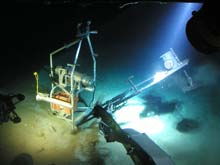
The bait deployment system on the EITS, known as the CLAM, is closed before it is recovered from the bottom. Click image for larger view and image credit.
Imagine if we had hundreds of similar “Eyes” … what could we see? In fact we are currently in the process of building another Eye In The Sea, thanks to a grant from the National Science Foundation. This one will be left alone for six months at a time at the bottom of Monterey Bay. Power and data will not be an issue, even for these extended time periods, since it will be connected to a cabled mooring operated by the Monterey Bay Aquarium Research Institute (MBARI). The great thing about this new version is that it will allow us to have a continuous "window into the deep" and will allow scientists, students, and teachers to conduct remote experiments on EITS via the Internet. Once again, technology is changing the way that we are able to look at the ocean.
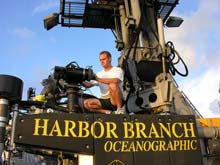
Lee Frey readies the LoLAR II instrument for deployment on the JSL submersible. Click image for larger view.
Another tool that we have been developing is the second generation of an instrument called the Low Light Autocalibrating Radiometer (LoLAR-II). This instrument is mounted to the top of the submersible and uses a very sensitive light sensor called a Photomultiplier Tube (PMT), along with a series of filters, to measure light over a very wide range. The operator sits inside of the submersible's sphere and controls the LoLAR and its pan & tilt mount via a laptop computer. The LoLAR can accurately measure from the brightest sunlight, all the way down to the dimmest of bioluminescent flashes. We use it to do a few different things. First, we can point it up and measure the downwelling of light at different wavelengths as the submersible descends. This can give us clues about the visual envoronment of an area and how human pollution is influencing water clarity. We can also use the LoLAR to explore bioluminescence, recording flashes of light as we move forward through the water. On LoLAR II, we have added a new capablility to measure a bizarre phenomenon known as flashback. Sometimes in the deep, when you flash the lights of the submersible out into the water, the "water" flashes back! Obviously this is a bioluminescent phenomenon, but up to this point no one knows what organism is making the light, or, more importantly, why and how it's happening. We hope that LoLAR will allow us to finally answer this question.
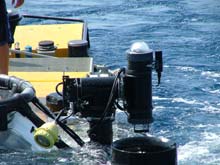
The LoLAR instrument is mounted in the up position to measure downwelling irradiance during a JSL dive. Click image for larger view and image credit.
As a final note, I often reflect on the fact that despite these great innovations in the name of science, engineers sometimes develop technology that harms the very ecosystems that we are studying. Engineering is a double-edged sword, and as our ability to create new and exciting technology exponentially increases, we have a responsibility to ensure that our achievements are moderated with good judgment. Hopefully the instruments and scientific tools that we design for these expeditions will help to be part of the solution, both by allowing us to explore further into the deep and by helping us to recognize the impacts that humans are having on it.


























